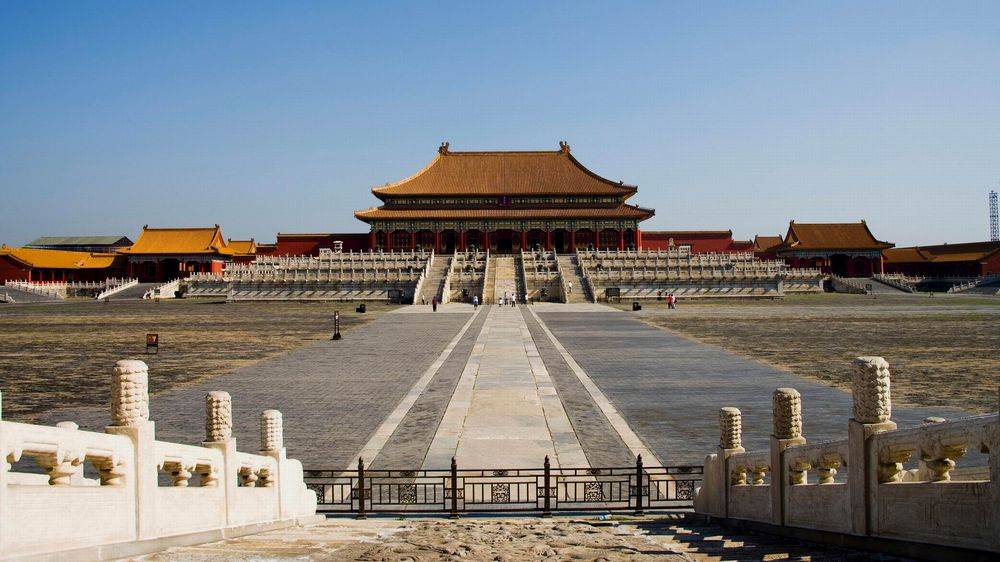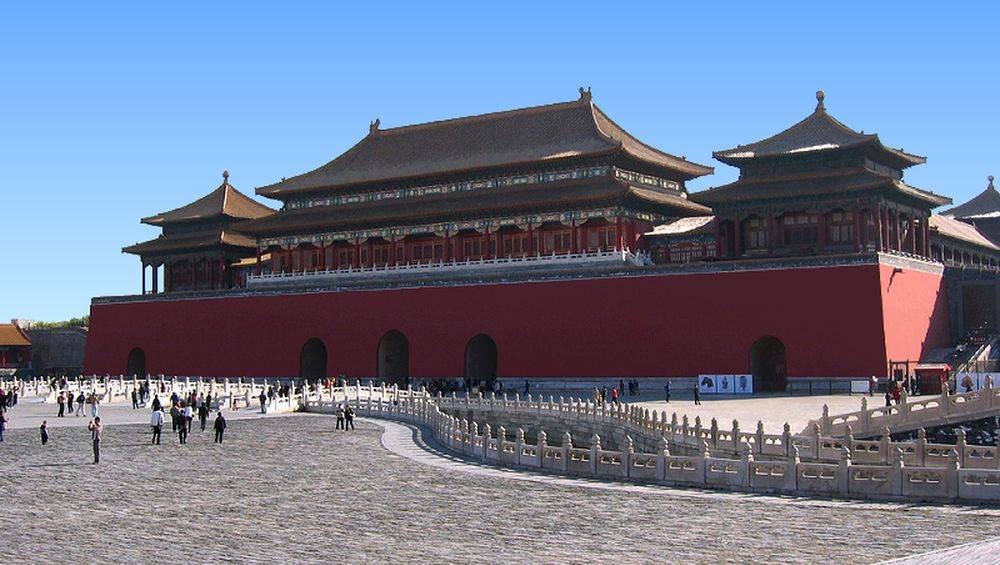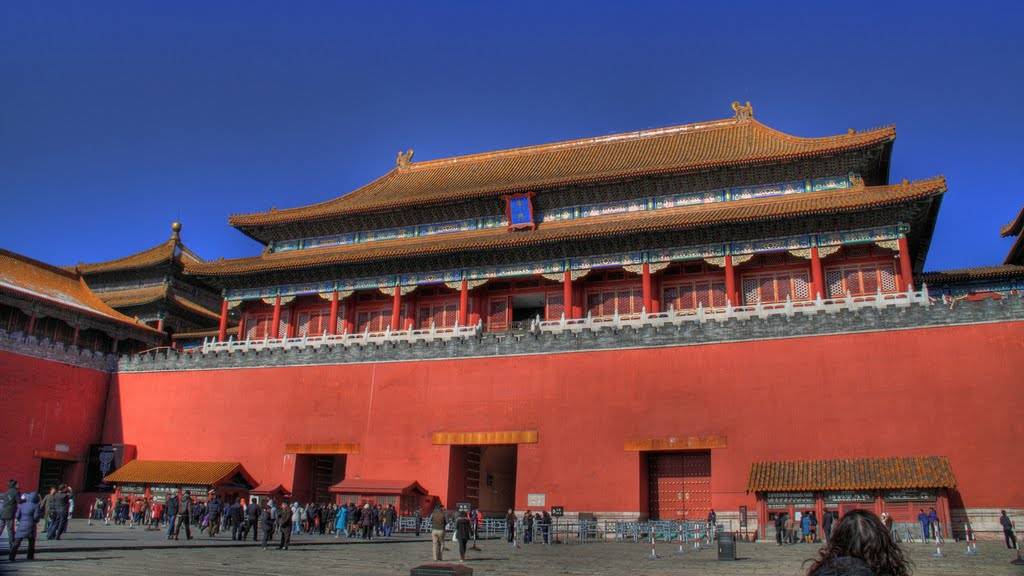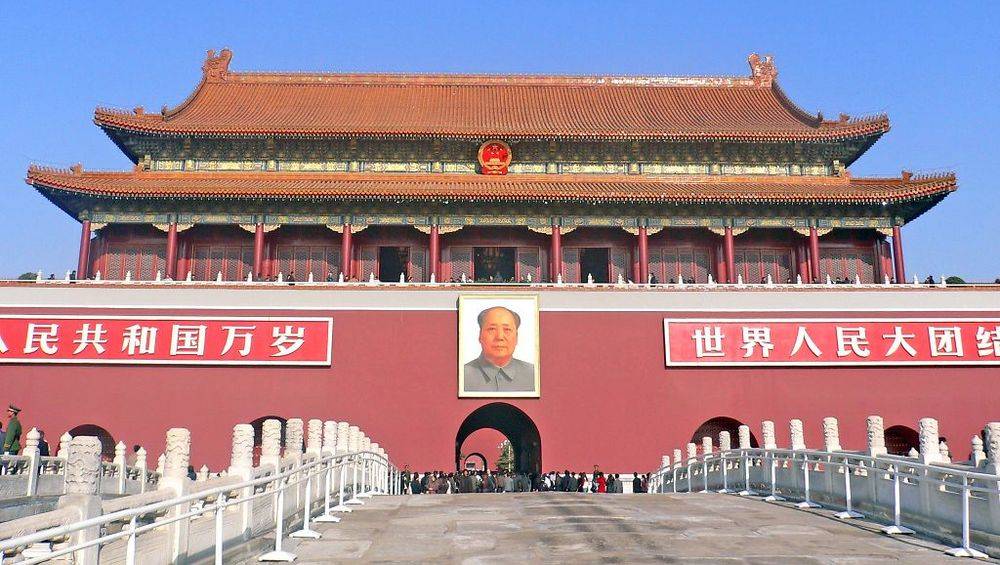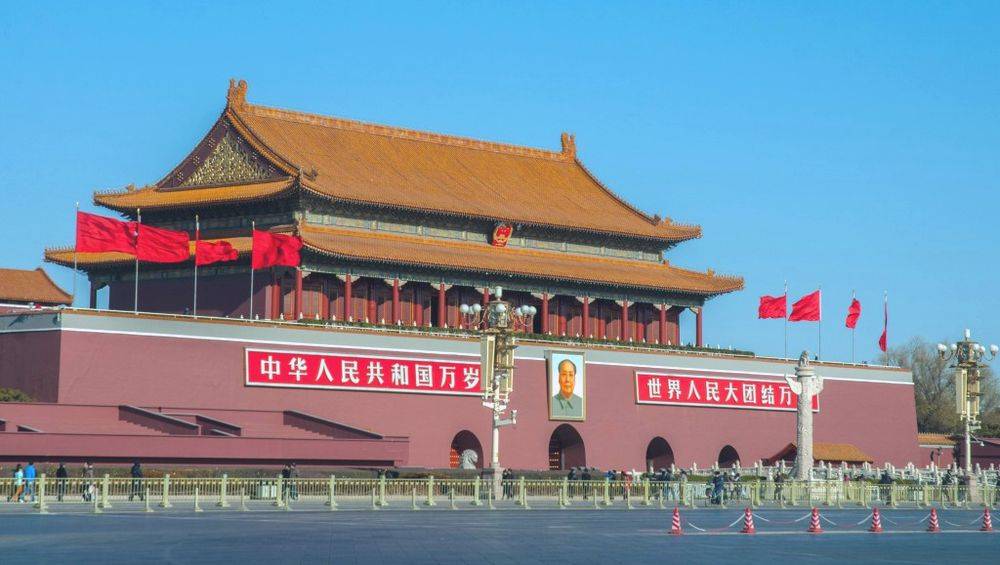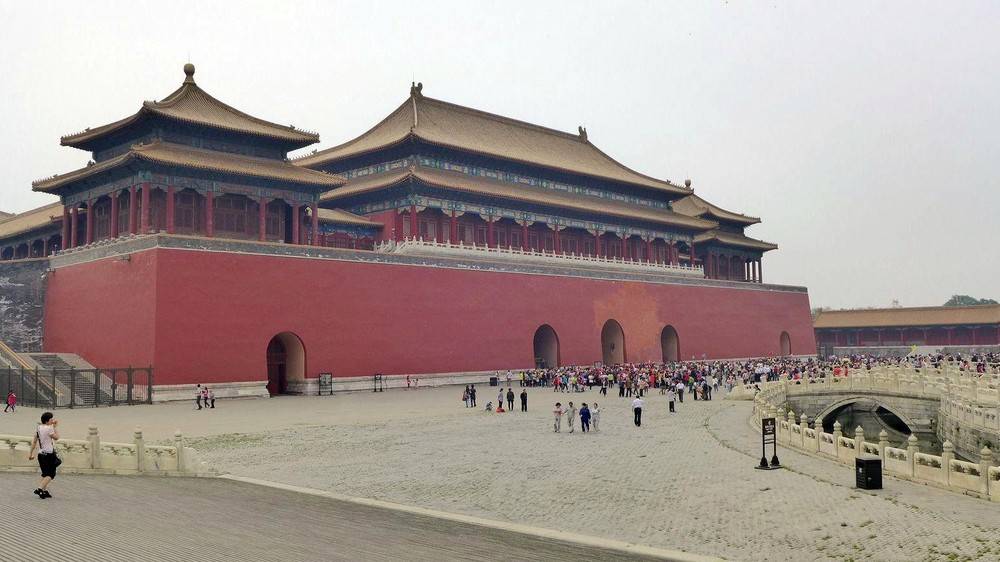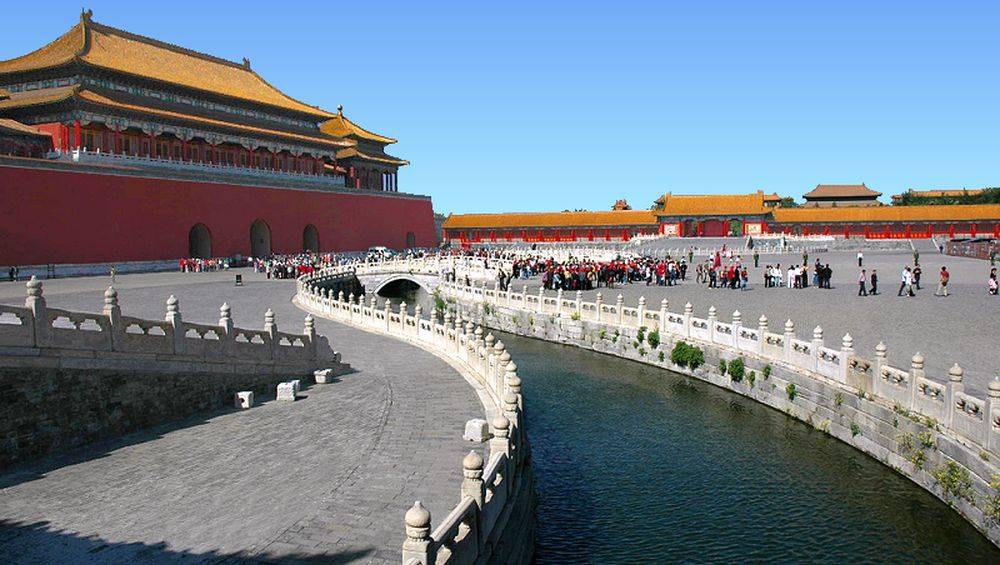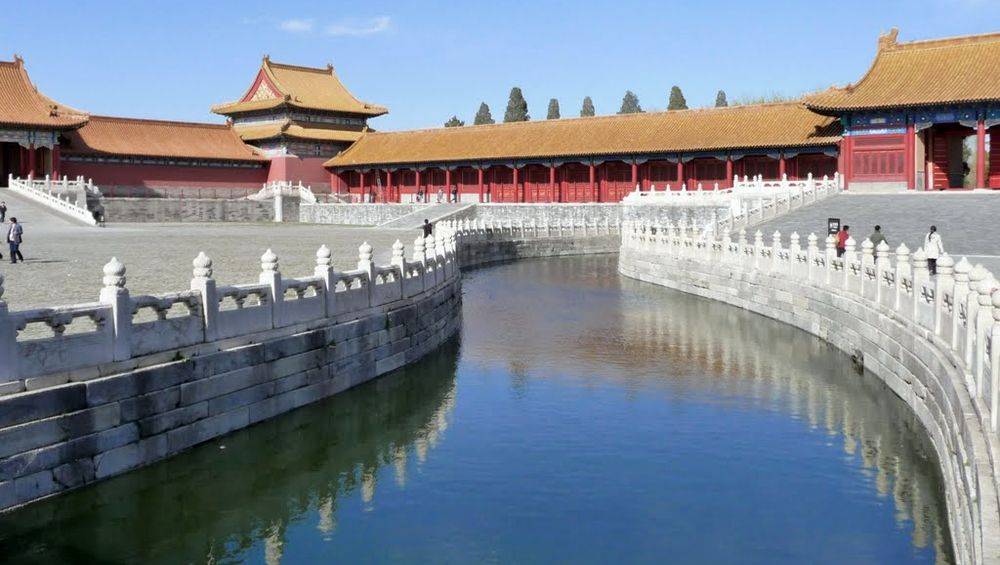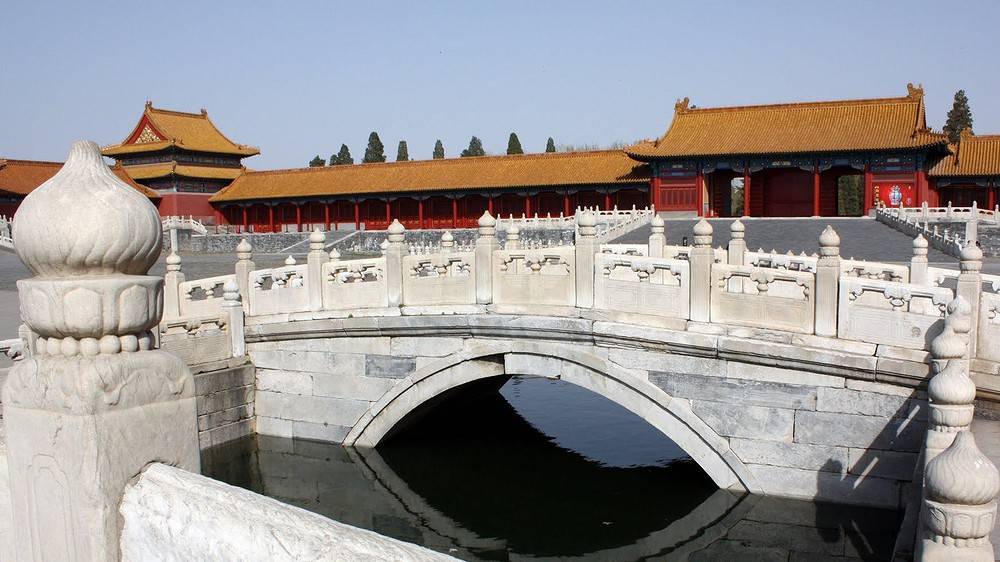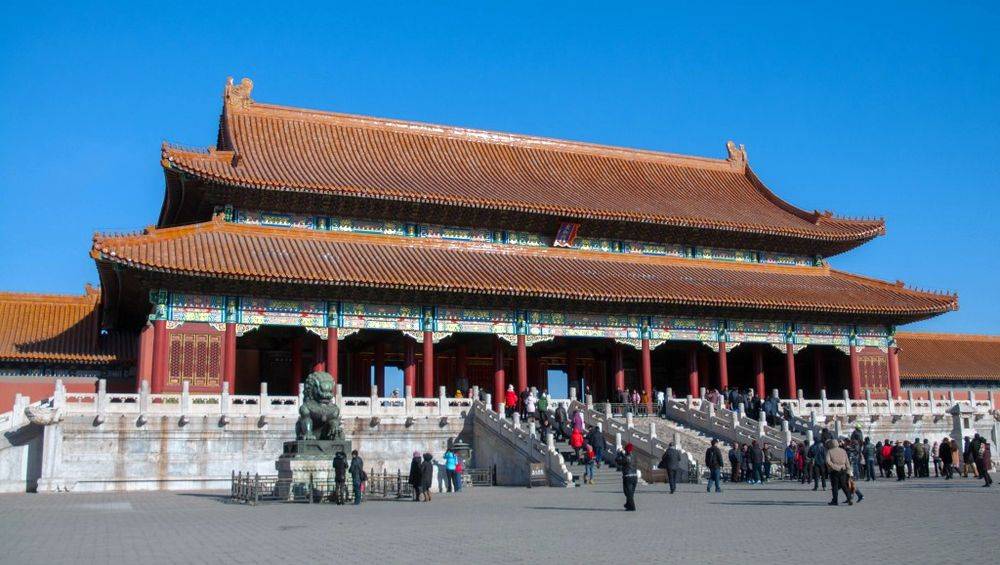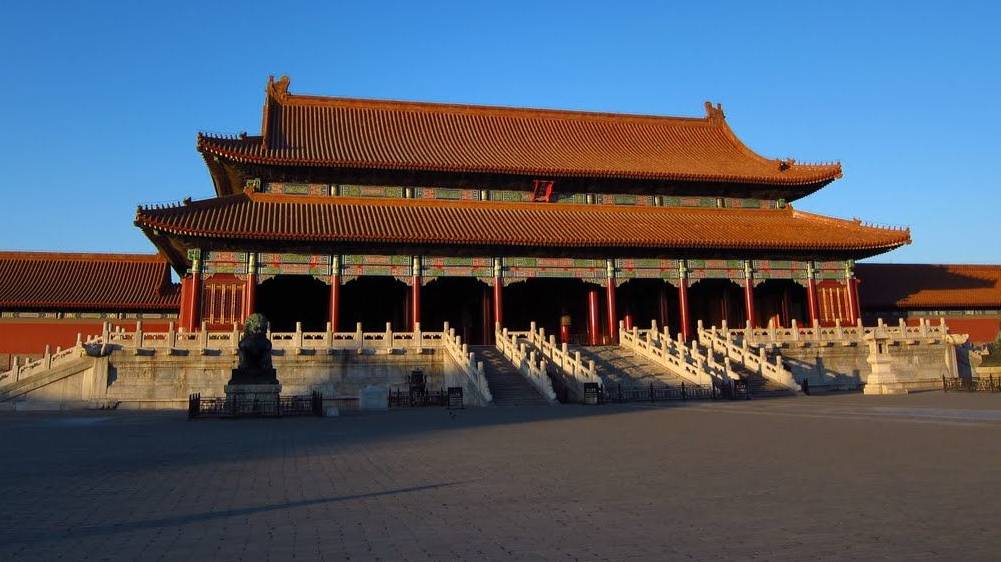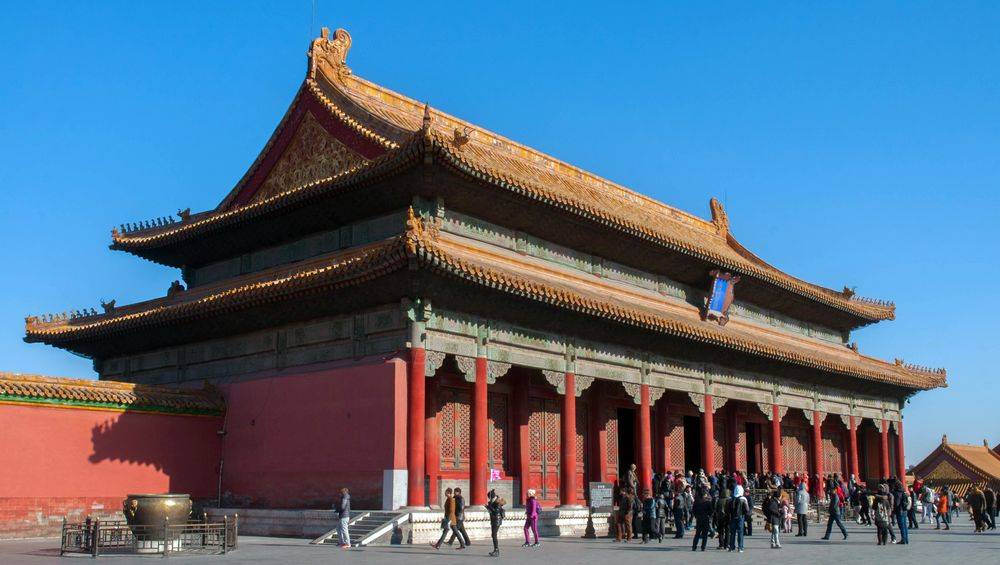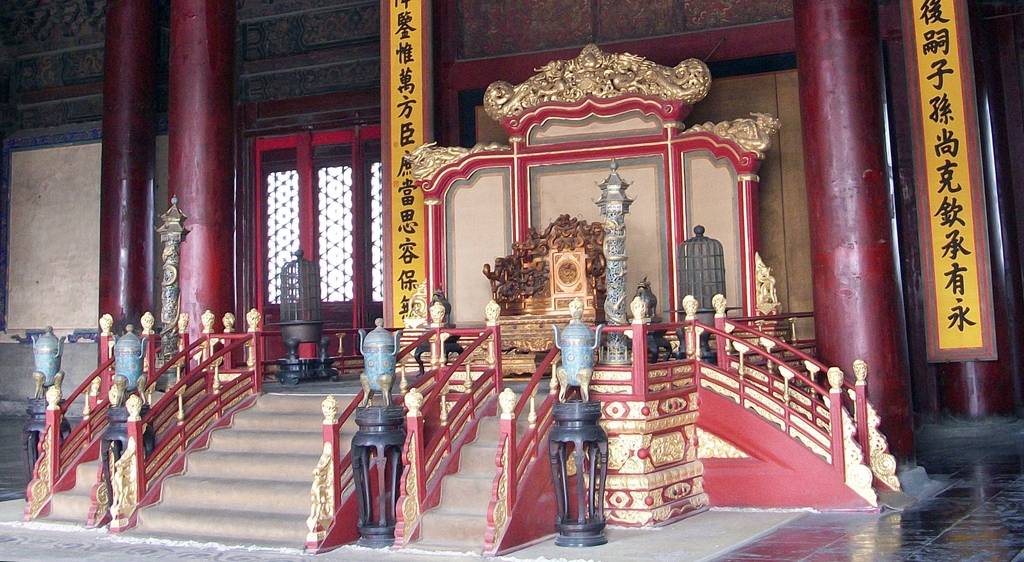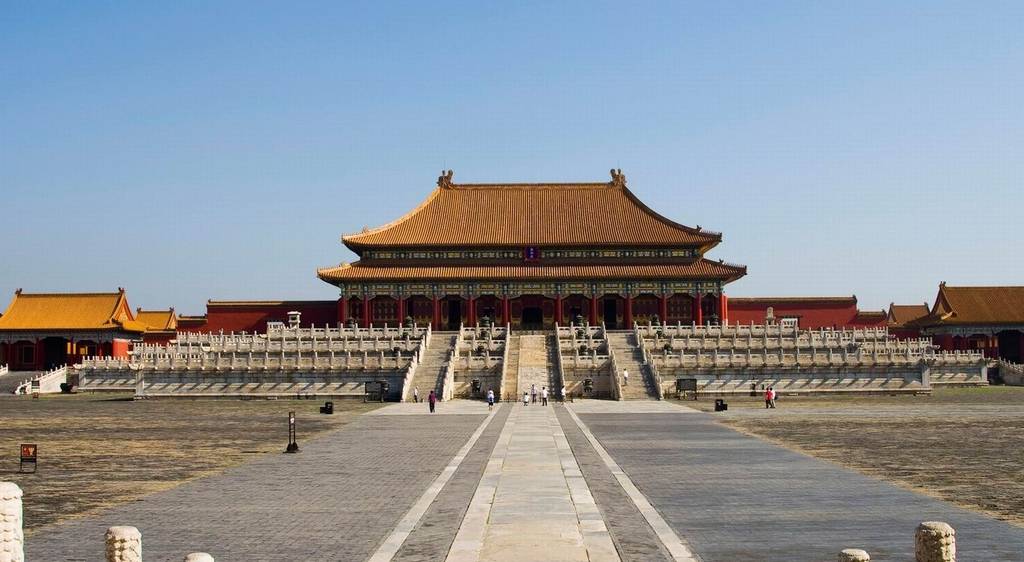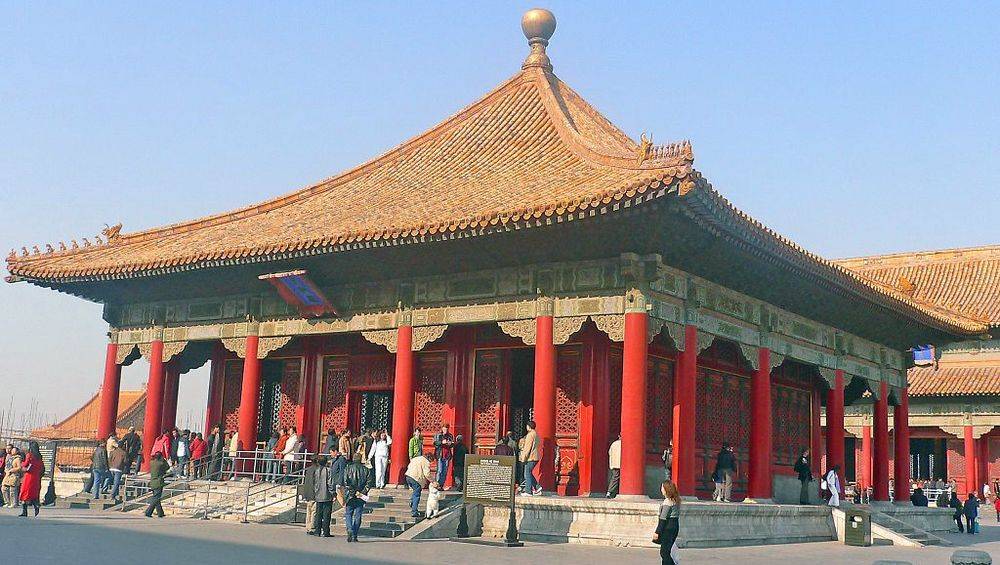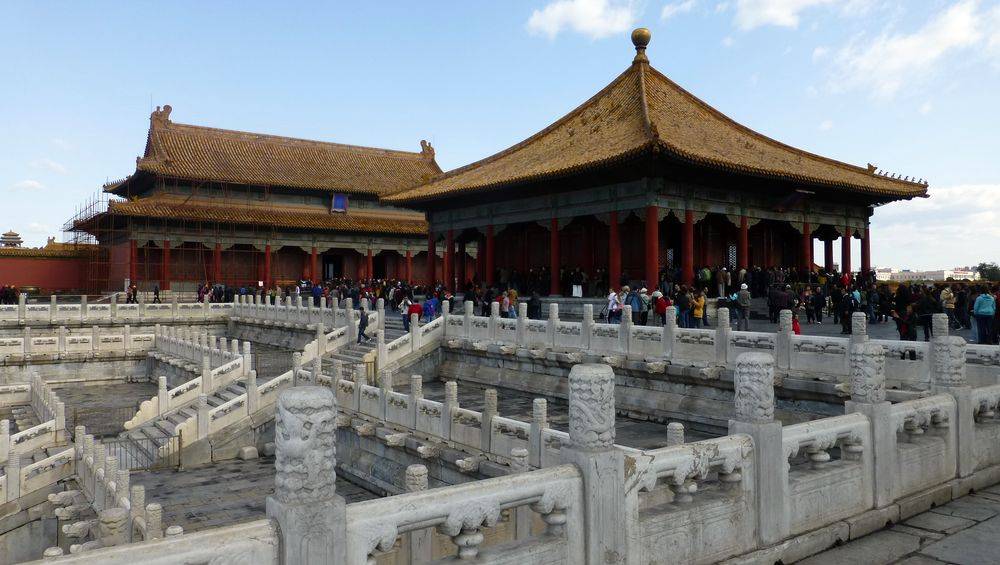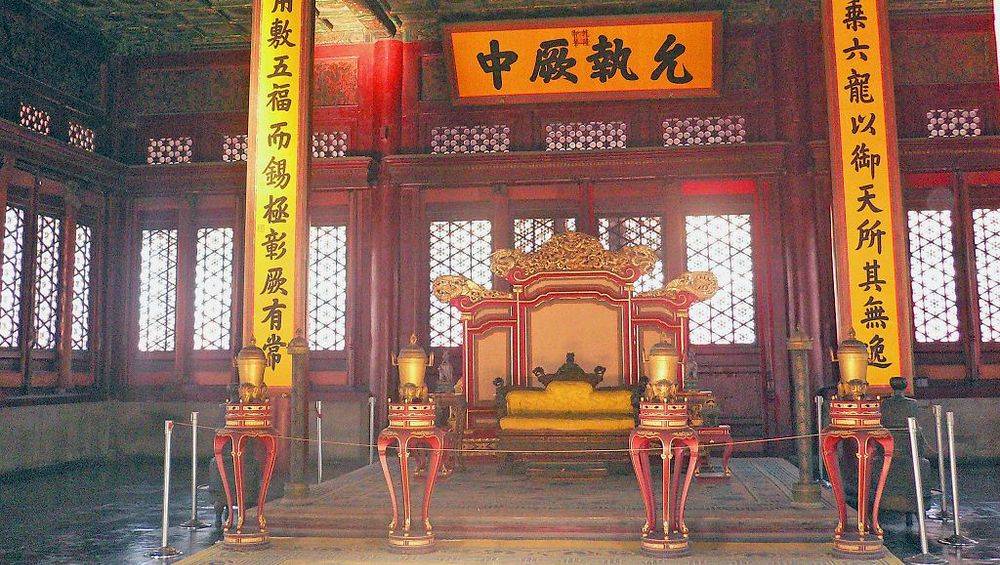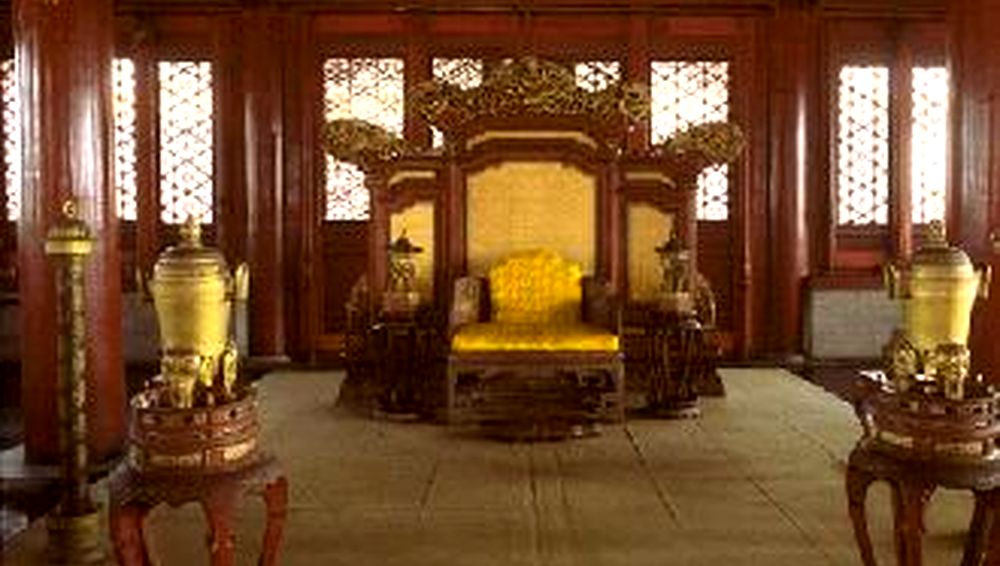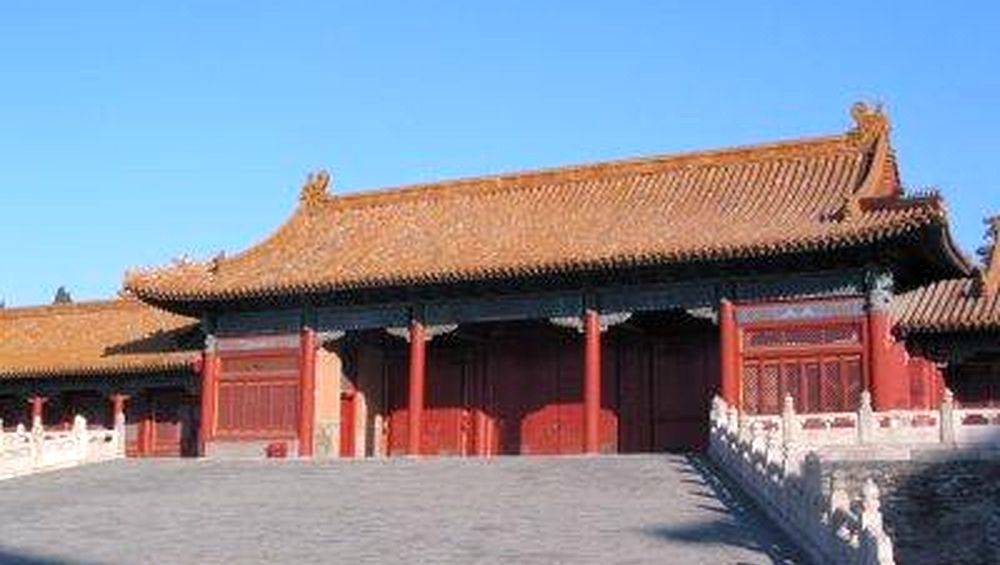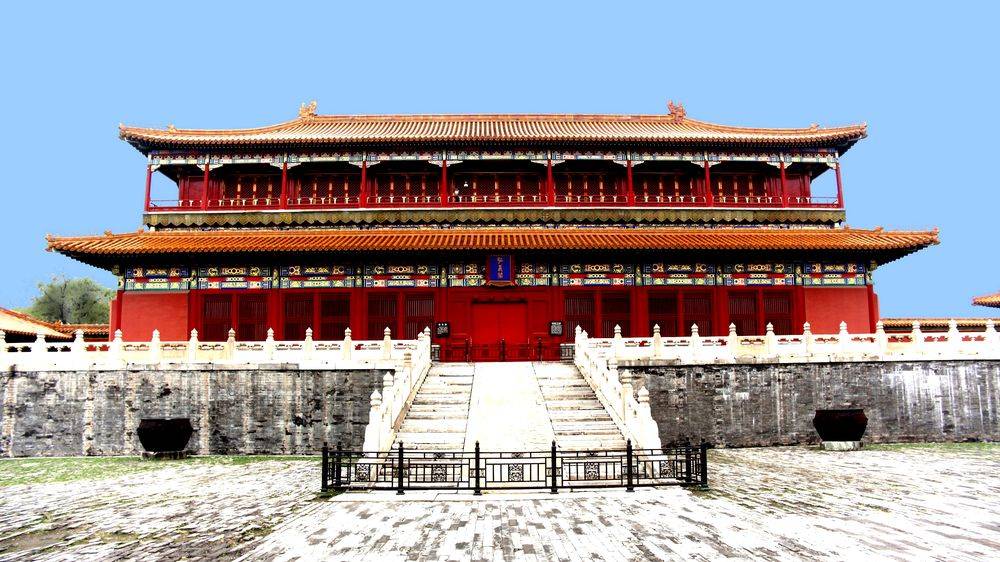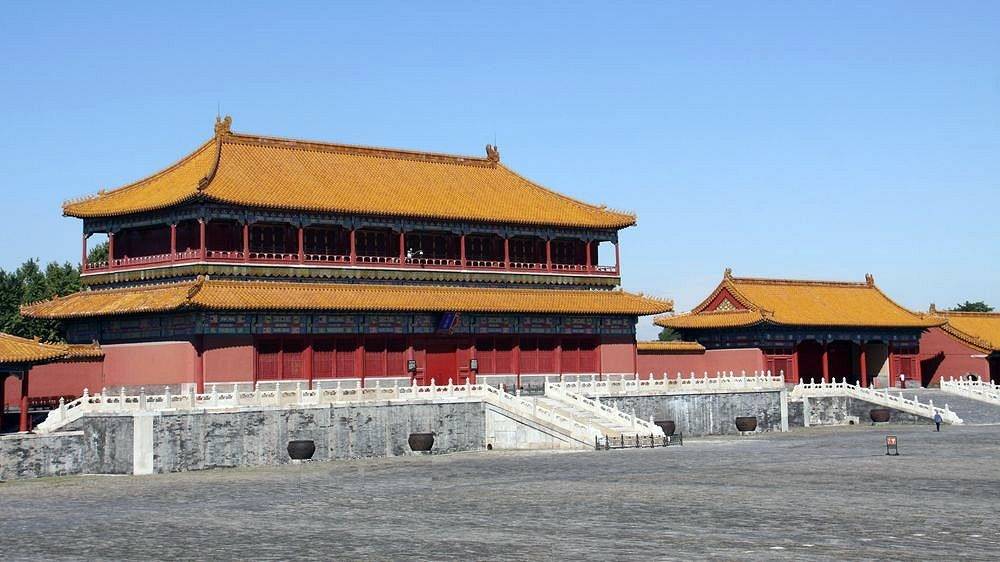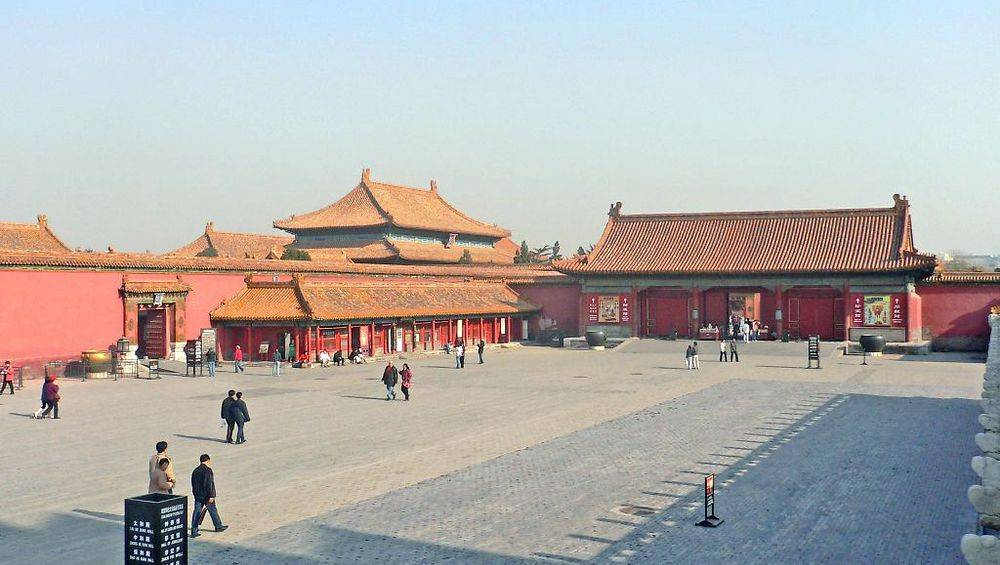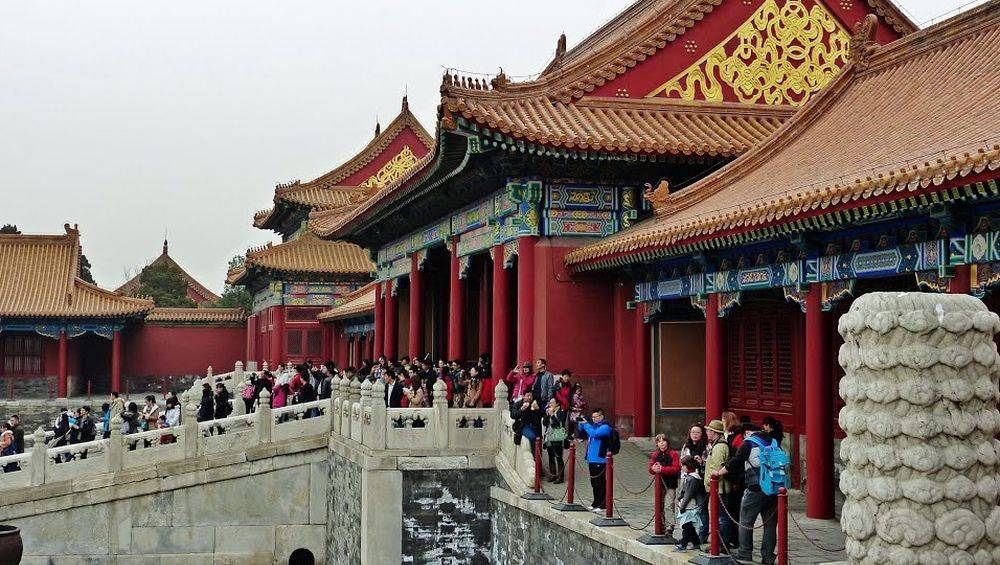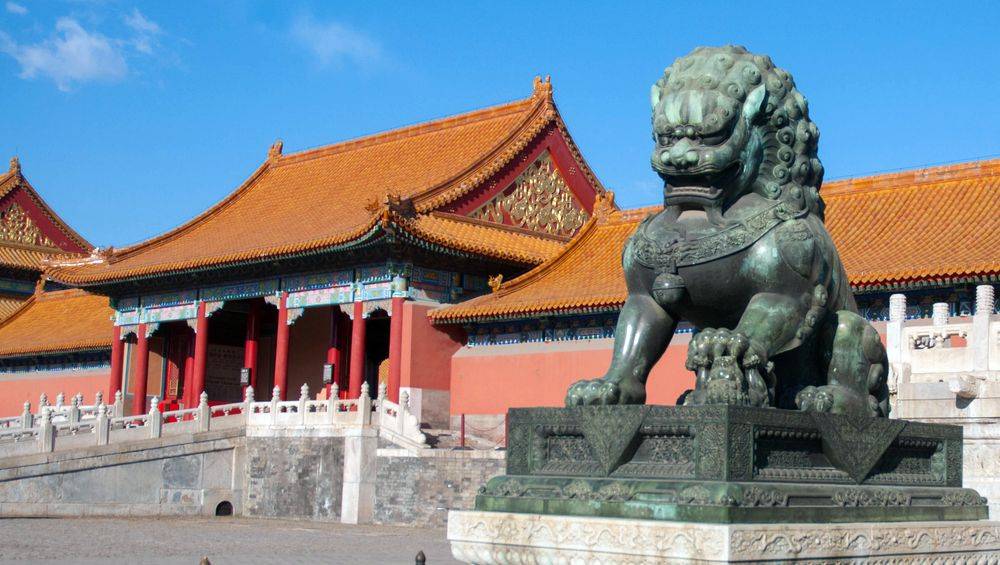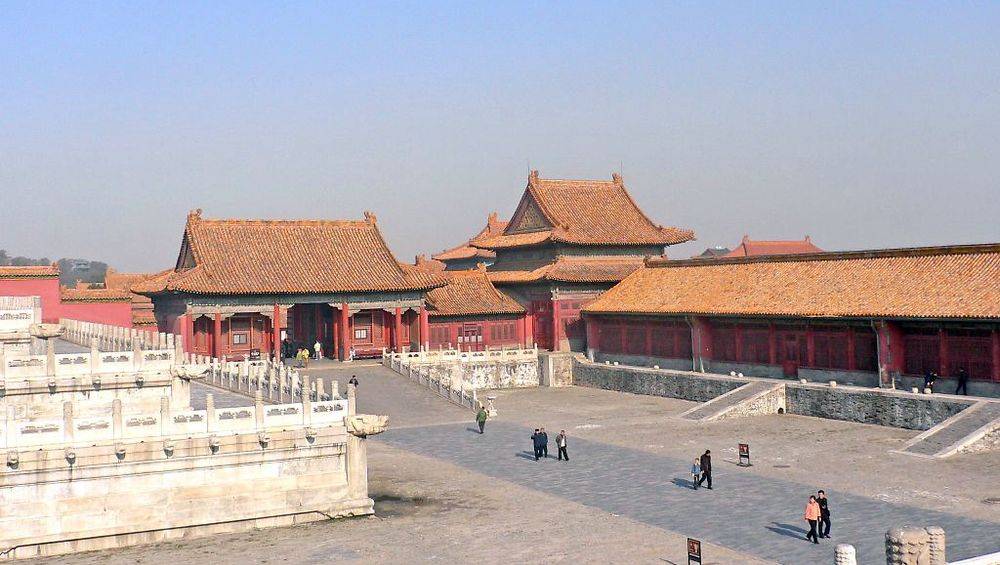The outer court of the Forbidden City was the most important place of Chinese politics. Nerve center of power, it was here that were made the major decisions of the emperor concerning his empire. The outer courtyard is actually a succession of courtyards, pavilions and doors, most of which had well-defined roles.
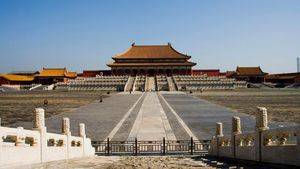
Outer court
The outer courtyard is the first part of the palace, the south. It is accessed mainly by the door of the south , the main entrance of the palace, the one with 5 arches. It consists of 3 courtyards: The Golden Water River Court and the Supreme Harmony Court, which is divided into two North / South parts. It is the latter that is the most impressive, it appears in the film "The last emperor", Bertolucci, that's why we recognize it often. The central pavilion is called Pavilion of Supreme Harmony, where the emperor received his visitors, mostly foreigners. It was both his office and a ceremonial room in which was his main throne.
To see in the outer court
If this area of the city is very large, it is especially all the decor that is to see, more than just specific collections. The door of the South is above all very impressive, it is at the same time a military stronghold and a room of ceremonies. The golden water river courtyard is interesting for its beautiful carved stone bridges. Finally, the court of supreme harmony gives an impression of space, so great is it. In summer, in the heat and pollution of Beijing, this courtyard is difficult to cross. Then the 3 central pavilions are the main attractions of the palace. From rooms decorated in decorated rooms, you will successively see the famous imperial throne, which has the characteristic of being in height, the 18 dings in bronze (reproductions of warships representing the 18 national provinces of the time), the magnificent marble balustrades, the many sculptures found in the various pavilions (dragons, herons, unicorns, etc.)
List of the pavilions in the outer court
La porte du Midi (Wumen)
Named Wumen in Chinese (Wu: Porte, Men: Méridional), the Porte du Midi is one of the 4 doors of the Forbidden City. Nowadays, it is the only possible entry, the others only serving occasionally or for practical reasons, not for the visit of the site. This is by far the most important of the four. Facing the south, it overlooks Tian'anmen Square where the ticket offices are located. This gate is on the north-south axis of the palace, right in the axis of symmetry. let us recall that the palace is as symmetrical as possible because it is a sign of balance, which was supposed to refer to the Chinese people.
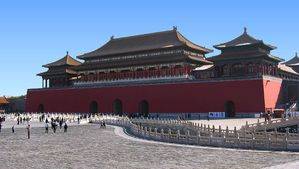
Meridian gate
Description
This door was built at the same time as the palace, between 1407 and 1420. More than just a hole in the wall, it is a tower imposing 37.95 meters high (124.5 feet). It has a concave layout with five towers, which gives it (it appears) the image of a flying Phoenix, hence its other name, "the tower of the 5 Phoenix" ("Wufenglou" in Chinese). The central tower, with double glazed roof tiles, measures 60.05 meters (198 feet) in length and 25 meters (82 feet) in width, for a height of 12 meters (39 feet). To the east and west of the main building two small towers are joined, towers of which go two covered corridors heading south, linking it to two smaller square towers. It forms a U-shaped assembly surmounting the openings of the wall. On the wall precisely, on each side of the frontispiece, there is one aperture per turn, making a total of five passages, one principal and four annexes, for the Porte du Midi.
The central building is quite massive, a long covered corridor actually turns. At both ends are two bells and drums whose functions were to announce the departure of the Emperor for the temple of Heaven for the bells and for the ancestral temple for the drums. Both were used at the same time during the great ceremonies that took place in the Hall of Supreme Harmony (Taihedian).
On the Tian'anmen Square, this door is equipped with two religious temples: the first is devoted to the ancestor worship of the dynasty and the other to the divinity of Earth and Grain. These are the tutelary gods of the Chinese imperial state. But there, we are not yet in the forbidden city.
The 5 passages
The passage of this door implied to comply with certain strict rules. The central gate was for the exclusive use of the emperor, but this rule was relaxed for two occasions.
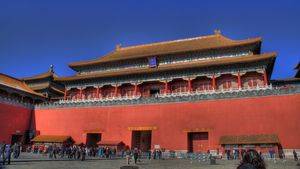
Meridian gate
The first was for an Empress who was able to cross this gate through the main passage on the day of her marriage. The second was to honor the three best Chinese scholars who obtained the highest rewards in the national examinations presided over by the emperor, who were allowed to pass through this passage after their interview with the emperor. The small gate to the east was used by ministers and officials, while the west gate was used by the royal family. The other two doors in the corners were used only when there were great ceremonies. In ancient times, the entrances and exits of the Forbidden City were very strict, this for the safety of the members of the Imperial family. People from the people had no entrance fee through any of these gates. Nowadays, the three central doors are available for all tourists. The two lateral doors have been modified and give access to amenities, mainly for tourists.
Use
The southern gate was the usual place for the promulgation of the writings of the emperors. In addition, a number of special events, ceremonies and special events were held here. On the 15th of January, according to the lunar calendar, was the feast day of the Lanterns. The emperor received the officials on this occasion (during the Ming Dynasty) in the central tower of the South Gate. As food was a strong symbol in China, he offered his ministers certain foods for the festivities, for example pastry on the first day of spring (February 4, always according to the lunar calendar), cold cakes (May 5, festival of the dragon boat, or the 9 of September, for the festival of Chyongyang) It is also here that the flagelations of the officials had been passed through the central tunnel, reserved to the emperor. In 1519 158 officials were punished of which 15 beaten to death. This cruel punishment was abolished at the end of the Ming dynasty.
On the tenth day of the lunar calendar the astronomical specialists presented to the emperor and his wife the calendar of the new year at the gate of the south. This calendar included the dates of the various ceremonies planned. Among the habits, it is sometimes thought that when the Chinese troops returned victorious from a battle, a sacrifice of prisoners was organized before the Porte du Midi. In fact, it was not true, this ceremony took place, but only for the criminals, and the vegetable market, in Beijing.
The door of the noon crossed, the visitor is in a big courtyard crossed by a river with 5 bridges, the river with the waters of gold.
Some photos

Meridian gate

Meridian gate
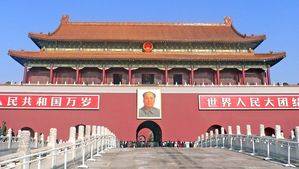
Meridian gate
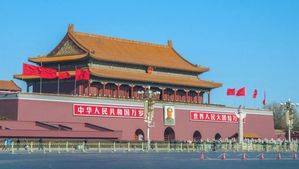
Meridian gate
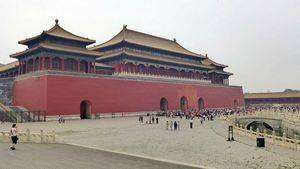
Meridian gate
The courtyard of the river of golden waters (Nei Jinshui qiao)
At the back of the south gate, this one just passed, the visitor is in a large courtyard surrounded by thick walls. It alone measures 10,000 square meters but is only one third of the next yard. North side is the gate of the supreme harmony, flanked by the small Zhendu and Zhaode gates, and on the west and east side there are also two other gates that lead to the sides of this courtyard, respectively the Xihe and Xiehe gates.
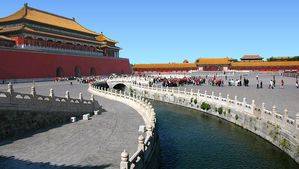
Bridge over the river with golden waters
The courtyard is crossed by an artificial river named the river with golden waters. Remember that yellow is the color of the Chinese emperor, so gold is everywhere in the forbidden city. Even if this river has gold only the name.
It follows a bed recalling the shape of a perfectly symmetrical Mongolian bow. It is approximately 5 meters wide and is shallow. The waters are rather stagnant because they come from moats. Initially free to circulate, the waters of this river were channeled by Emperor Zhengtong (1436-1449) when he imposed the creation of control valves of water flow in the ditches and in this river. Thus the river could serve as a reservoir in case of fire, which occurred relatively frequently, the whole palace being wooden. He took the opportunity to do other work: The bridges that cross the river of golden waters were rebuilt in stone to replace the original wooden bridges.
With regard to these bridges one must know that there were five of them, a figure that often comes down in Chinese art, religion and traditions. One is central, two framing, and two others are theirs, a little further. Like the passages in the Porte du Midi, the central bridge was reserved for the emperor, while the secondary bridges were used by members of the royal family. The other two bridges were for use by justice officials. These bridges are richly decorated, their balustrades are marble carved dragon and phoenix. These balustrades are not only on the bridges, they continue along the bed of the river. If the number 5 comes back so often, it is also because, according to the Confucian teachings, there are 5 virtues: Humanity, the sense of duty, the wisdom, the safety and and the observance of the ceremonial. Each of the bridges represents one of these virtues.
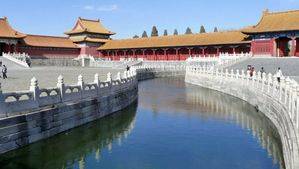
The river with golden waters
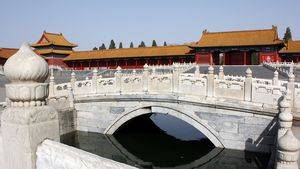
Bridge over the river with golden waters
La Gate of supreme harmony (Taihemen)
The gate of supreme harmony separates the first court, that of the river with golden waters, from the court of the Palace of Supreme Harmony, the principal palace of the Forbidden City. It is a very important door. This door is guarded by two bronze lions. This is symbols of the imperial power. The lion on the east side is a male. His right front paw is placed on a globe indicating the imperial power extended throughout the world. The lioness on the west side has her left front paw on a lion cub. It represents the flourishing and prosperous imperial family. The rooms on each side would have served as warehouses to store items such as fur, porcelain, silver, tea, silk, satin and clothing.
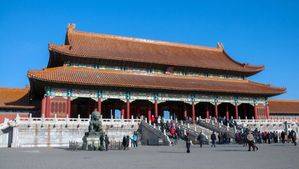
Gate of supreme harmony
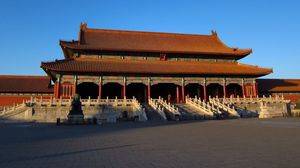
Gate of supreme harmony
This door is open on a thick wall covered with glazed tiles. More than just an opening, it is about 20 meters long, built on marble foundations rising to a height of 2 meters. There are two steep stairs to access, the two stairs are marble with decorated balustrades. At the entrance, there is a lion statue.
As the building is often rectangular, it has a double glazed tile roof with predominantly yellow, the color of the emperor. Each end of the roof has an imposing decorative element. On the ground floor is a lined arcades decorated, painted wood. There are 9 on the length and 4 on the width. The whole building is 1300 square meters. The wall that extends it is pierced by two other doors, more modest, but which are also two small pavilions in themselves: The door Zhendu (west) and the door Zhaode (East). They are identical, a kind of small pavilion without exterior wall and with a large single roof of yellow glazed tiles.
This building was not just a door, it was mainly the main hall in which the Ming emperors regulated the affairs of the state. The ceremonial was well oiled: Mandarins and soldiers came here early and waited for the imperial audience. The emperor was working on the throne. Thereafter the courtroom will be transferred to the Palace of Heavenly Purity, in the inner courtyard.
Pavilion of the supreme harmony (Baohedian)
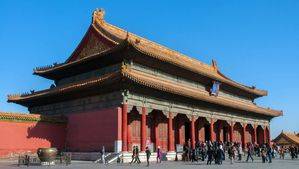
Pavilion of the supreme harmony
The Pavilion of Supreme Harmony is named "Taihedian" in Chinese. This is the main palace of the emperor. It is north of the large outer courtyard, the largest in the Forbidden City, which is still a trifling 30,000 square meters. The palace is raised about five meters, the whole basement being made of layers of marble superimposed staggered. Only the basement has three levels.
It is the palace of the emperor. There he received senior officials but especially foreign delegations. All the great ceremonies were held here, especially during the advent of the new emperors. Anniversaries, weddings, and other occasions were also celebrated, such as the celebration of the winter solstice, the Chinese New Year, and declarations of war.
When the visitor climbs one of the three imposing staircases he can not help but notice the presence of 18 bronze dings, a kind of Chinese antique ship. Each of them represents one of the national provinces of the time. On the marble terraces the balustrades are luxuriously decorated with cranes and bronze turtles, symbols of domination and eternal longevity. There are also two gilt bronze vats in front of the building, which were used to store water in case of fire.
This building is the tallest of all the buildings in the Forbidden City, at least it was in the Ming and Qing dynasties. No other could be higher, for the Emperor could never be below anything at any time. Only takes place this palace is a symbol of imperial power
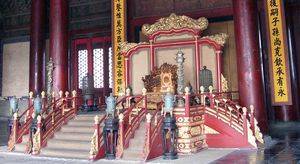
The imperial throne
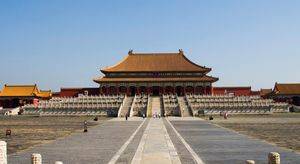
The pavilion and the courtyard
The hall is 35.02 meters high (37.44 meters, including the decoration on the roof). it is 63.96 meters wide and 37.2 meters long respectively. There are a total of 72 pillars, in six lines, supporting the roof. The doors and windows are embossed with clouds and carved dragons. Inside, the floor is paved with special bricks that have been worn out by the weather. Best symbol of imperial power, the throne of sandalwood, standing on a platform two meters high, is located in the center of the room, surrounded by six pillars of thick lacquered gold adorned with dragons. Other dragons are carved in the golden throne. Around the throne stand two bronze cranes, an incense burner in the shape of an elephant and a tripod in the shape of a mythical beast. It is richly decorated with dragons, giving an aura of solemnity and mystery.
In the center of the ceiling are two dragons playing with pearls. They were made of glass and painted with mercury. The pearl was supposed to have the ability to detect a usurper to imperial power. If someone who was not the descendant of Emperor Huang Di and thus usurped the throne, the pearl had to come down and hit him dead.
In front of the palace, on the white marble terrace, the visitor can see two curious objects: a sundial and a grain measure. These are symbols of imperial justice, quite simply.
Pavilion of the Middle Harmony (Zhonghedian)
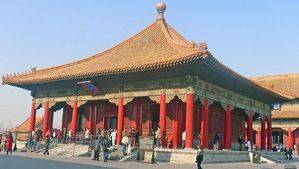
Pavilion of the Middle Harmony
It is located between the Palace of Supreme Harmony (Taihedian, in Chinese) in the South and the Room of Preserved Harmony (Baohedian, in Chinese) in the North. These three pavilions are known as the "Three Great Halls of the Outside Courtyard" and are located along an axis of symmetry of the Forbidden City, a North-South axis. This is the smallest of the three, it has only a floor area of 580 square meters. It is based on a square plan of 24.15m side. It has a unique roof whose golden pinnacle shines surprisingly in the sun. As the crow flies, the three palaces are arranged so as to please the Gods, who are supposed to watch the palace from above. Their different forms break the monotony and the dimensions of each are calculated to preserve the Chinese architectural style, which is the proof of the mastery of the architects.
Built in 1420 during the eighteenth year of Emperor Yongle's reign (1403-1424), this pavilion was named "Huagaidian" at the beginning of the Ming Dynasty (1368-1644). Under the reign of Emperor Jiajing (1522-1566), he was renamed "Zhongjidian" after his reconstruction. Ink marks of three Chinese characters (Zhong Ji Dian) can still be seen. After having undergone three fires, this pavilion takes its present appearance which corresponds to what it was to its construction in 1627, during the seventh year of Emperor Tianqi (1621-1627) of the Ming Dynasty (1368-1644) .
The interior of the room
This pavilion was the resting place of the emperor when he was organizing the ceremonies that took place in the hall of supreme harmony. It was a bit of a waiting room, before receiving his ministers or officials. Each year, before leaving for the important sacrificial rites at the Temple of Heaven, at the Temple of the Earth or elsewhere, he came here to prepare himself. It was here also that he verified the quality of the sowing that would be used at the altar of the God of Agriculture (Xiannongtan) during the ceremony in his honor, a ceremony that opened the plantation era. The gardening tools were also symbolically used during this ceremony.
Inside, visitors can see a pair of unicorns of gold standing on either side of the throne, which is in the center of course. Called "Luduan" in Chinese, unicorns are mythological animals capable, according to the Chinese, of speaking several languages and traveling 9000 km in one day. It is of course for these abilities that they have been widely used in the statuary of the palace. They were also a symbol of the great wisdom and intelligence of the emperor. On the side are bronze censers used to make fire, to warm up. Beside the throne there are two sedan chairs used for the transport of the emperor in the Forbidden City. There were strict rules regarding the use and type of sedan chair that the emperor was to take.
Photos
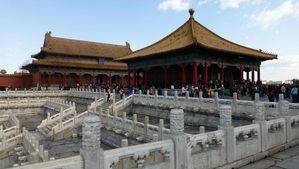
Pavilion of the Middle Harmony
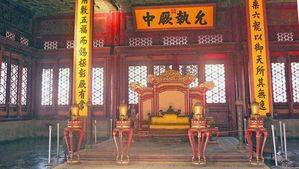
The throne of the middle harmony
Pavilion of the preserved harmony (Baohedian)

Pavilion of the preserved harmony
Third and last pavilion of the outer courtyard, it is at the north end of the three-level marble terrace. Similar to the other two in style, but a little smaller than the Hall of Supreme Harmony, it is larger than the Palace of Central Harmony. It was built in 1420, rebuilt in 1625 and renovated in 1765. Ming emperors used it to change clothes during ritual ceremonies. The emperors of the Qing dynasty changed their function: it was customary that the imperial banquets held here. These banquets were held during the great ceremonies, to celebrate the marriage of a princess for example. The emperor also used it to entertain certain high officials, deserving and their families, those who had served the imperial government well. Every year, on the eve of New Year's Eve, a banquet was held to honor the governors of the provinces, the Mongol princes, and some civil and military officials.
In the middle of the Qing Dynasty in 1789, Emperor Qianlong decided that the final phase of the compulsory National Examination, which had enabled a large part of the Chinese population to be marked, would be held in the pavilion of the " harmony preserved. It was the equivalent of the highest level of the system of imperial examinations at the national level, and the emperor thus honored the first ten candidates selected by reading the papers they had submitted.
On rainy days, visitors will have the chance to enjoy the spectacular view of the thousand dragons vomiting water. There are a total of 1412 marble dragon heads along the columns of the three-tiered terrace leading to the three pavilions. Chinese craftsmen skillfully combined the storm drainage system with these architectural features.
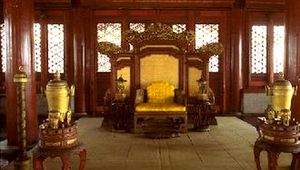
The throne of the preserved harmony pavilion
It is also worth noting the presence of an enormous marble sculpture representing nine dragons playing with pearls. It is the largest stone sculpture in the Forbidden City. Sculpted under the Ming Dynasty, it was re-sculpted under the Qing Dynasty. During these dynasties, anyone who was surprised to touch this sacred stone was punished with death. Weighing about 250 tons, the marble slab is 16.57 meters long, 3.07 meters wide and 1.7 meters thick. The huge stone that served was transported here from Fangshan, 70 kilometers from Beijing. This difficult task lasted about a month and required the use of 20,000 men and thousands of mules and horses. It is said that it was done in winter, and that a well was dug every 500m all the way. By extracting the iced water and spreading it on the ground it formed a frozen road on which the rock could slide.
Leaving the Pavilion by the North
Outside the pavilion of the Harmony Preserve, in the direction of the North, the visitor leaves the outer courtyard and stands facing the door of the Celestial Purity, which marks the entrance of the private parts dedicated to the emperors. Between the two, the visitor is in a small rectangular court decorated with two wells, the door named Longzong (left) and the door Jingyun (right). There is also the Privy Council Office, a small long building created in 1729 to settle urgent matters, when Qing troops fought against the Mongols in northern China. Subsequently this office was strengthened and converted into a black cabinet of the emperor. He then had even more power than the classic imperial council, but that was all there is more secrecy. Only the emperor and a few authorized persons had the right to go there, not all others were to linger in the corner. Symmetrically to this office is the building named Jiuqingzhifang. It is simply a place of restoration today.
Gate of unified harmony (Xiehemen)
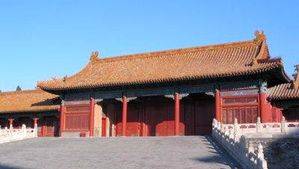
Gate of unified harmony
The door of mutual harmony separates the outer courtyard to the eastern part of the outer annexes, it is through this passage that we can go to the pavilion of literary glory through the park that is there find. The eastern gate of the Forbidden City and the Grand Secretariat of the Ming Dynasty are also accessible. This door was originally called Gate of Obedience. Emperor Shunzhi, who reigned from 1644 to 1661, renamed it after its restoration. During the mid-fifteenth century war, Emperor Jingtai (1450-1456) held his noon hearings here.
Another fact occurred at this gate in 1425. In the early years of Jiajing's reign (1522-1567) there was a controversy in the adoption of the imperial lineage. To mark their disapproval of the Emperor's decisions, some 200 ministers knelt at that door and shouted violently to make their voices heard.
Pavilion of rigorous justice (Hongyi ge)
Located south-west of the Hall of Supreme Harmony, the Pavilion of Rigorous Justice was originally known as the "Martial Pavilion" (Wu lou) its original name. During Jiajing's reign he was changed to "hall of Martial Victories". His current name was given to him by the Qing emperors (1644-1911). During this dynasty it was used to store gold and silver ritual instruments.
Measuring 9 bays long and 3 floors, the building has the particularity of not having a window on the first two floors. This is where was stored the encyclopedia of the era of Emperor Chengzu (Ming Dynasty)
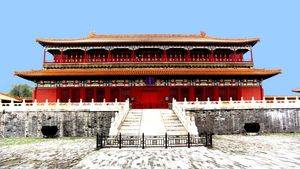
Pavilion of rigorous justice
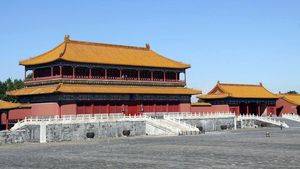
Pavilion of rigorous justice
Belvedere of the embodying benevolence (Tiren ge)
The belvedere of benevolence was originally called the civil belvedere (wen lou). Its current name was given by the Qing emperors who were inspired by the ancient writings. It is to the south-east of the pavilion of the supreme harmony, it dates from the Qianlong period (1736-1795). Emperor Kangxi (1662-1722) used the pavilion to test candidates for ministers on poetry. Since the reign of Emperor Qianlong this pavilion has been used as dressing room of the royal family, making it a real royal clothing store.
Gate of good fortune (Jingyun men)
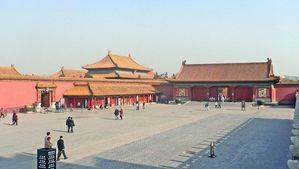
Gate of good fortune
In the Qing Dynasty, with the exception of officials on duty or those who were summoned to the public, no one was allowed to go through that door without a thorough check. In order to ensure the security of the inner courtyard, all comers had to stop at 20 steps from the gates and indicate the reason for their coming to the messengers who then made the round trip to the person to meet.
Gate of unified harmony (Xiehemen)

Gate of unified harmony
The door of mutual harmony separates the outer courtyard to the eastern part of the outer annexes, it is through this passage that we can go to the pavilion of literary glory through the park that is there find. The eastern gate of the Forbidden City and the Grand Secretariat of the Ming Dynasty are also accessible. This door was originally called Gate of Obedience. Emperor Shunzhi, who reigned from 1644 to 1661, renamed it after its restoration. During the mid-fifteenth century war, Emperor Jingtai (1450-1456) held his noon hearings here.
Another fact occurred at this gate in 1425. In the early years of Jiajing's reign (1522-1567) there was a controversy in the adoption of the imperial lineage. To mark their disapproval of the Emperor's decisions, some 200 ministers knelt at that door and shouted violently to make their voices heard.
Gate of the correct conduct (Zendhu men)
The door of the correct way allows to join the external court of the river of the river to the waters of gold, without it being the main door. It is to the west of this door, the door of the supreme harmony.
Gate of manifest vertue (Zhaode men)
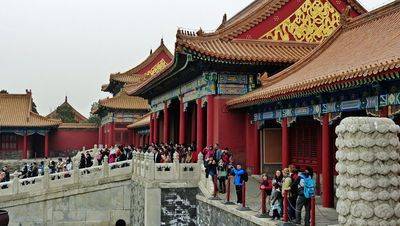
Gate of manifest vertue
During the doorway of the correct conduct, the door of manifesting virtue is east of the gate of supreme harmony. During the Ming Dynasty (1368-1644), the door of manifest virtue was the place where the emperor summoned ministers to discuss matters when he wanted to speak outside the formal protocol. It is here that the offices of the Grand Secretariat have been established. Under the Qing (1644-1911), it was the night guard for the imperial guards.
This gate was originally called "Northeast corner gate" (Dong jiao men), then under the Ming it was named the "Gate of the extension of the Administration" (Hongzheng men). She received the current name of Qing rulers (1644-1911).
Right-wing gate (You yimen)
The door of the right wing is along the west wall of the outer court, north of the hall of rigorous justice. It is very similar to the door of the left wing, ie it is an architecturally simple door but whose roof is very decorated. The pediment is a model so much it is carved. In addition he has varied paintings of all beauties. The roof is also decorated with a succession of ceramic dragons.
Middle right gate (Zhongyou men)
The right central door is one of the small doors of the outer courtyard. It connects the court of supreme harmony to the courtyard of the middle harmony pavilion. This door has no particularities, it is certainly very beautiful but nothing special, except the large ramp that allows to climb.
Left-wing gate (You yimen)
The left central gate is one of the small doors of the outer courtyard. It connects the court of supreme harmony to the courtyard of the middle harmony pavilion, from the left.
Middle left gate (Zhon zuo men)
The left central door is one of the small doors of the outer courtyard. It connects the court of supreme harmony to the courtyard of the middle harmony pavilion, from the left.
Left rear gate (Houyou men)
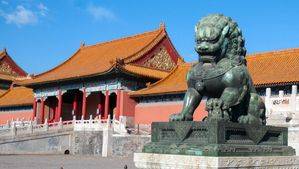
Left rear gate
The left and right rear gates flank the pavilion of preserved harmony, they serve as secondary doors accessing the courtyard of the middle harmony.
Right rear gate (Houyou men)
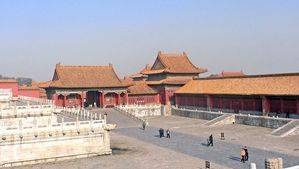
Right rear gate
The left and right rear doors flank the pavilion of preserved harmony, they serve as secondary doors accessing the courtyard of the middle harmony.
Gate of thriving imperial clan (Longzong men)
The door of the prosperous imperial clan is the counterpart of the door of good fortune, it is its opposite. It leads to the residence of the Empress Dowager. Even imperial parents and high officials could not cross that door leading to the inner courtyard without either an emergency or the Emperor's request. The office of the Grand Council of State (Junji Chu) was located just inside this door.
The coffins of the Qing emperors who died outside the Forbidden City were carried by this door into the palace where a mourning group was gathered. During the reign of Jiaqing (1796-1820), a fierce struggle between rebel peasants and imperial guards took place at this gate in 1813. The guards successfully blocked the rebels in the inner courtyard by closing the gates. The half-arrow now glued to the name of the plate is a reminder of this struggle.
See also:






